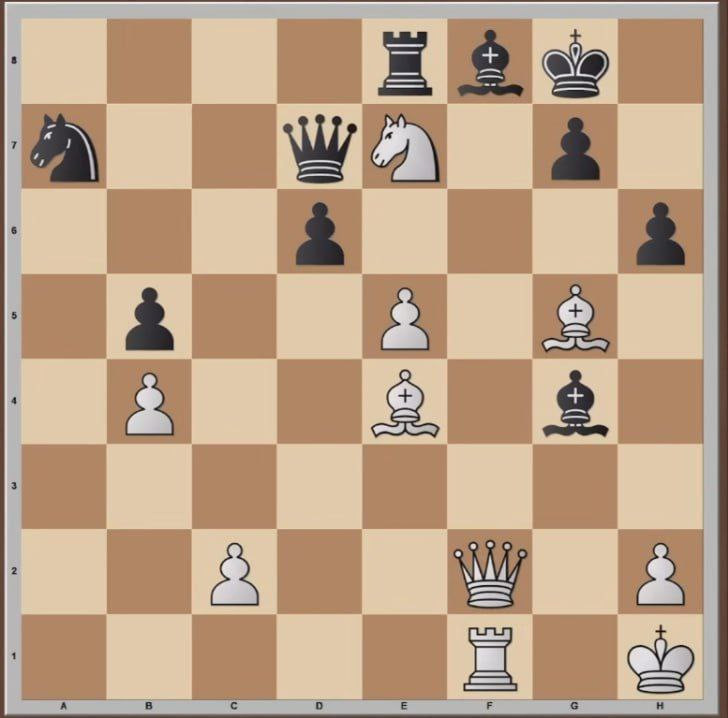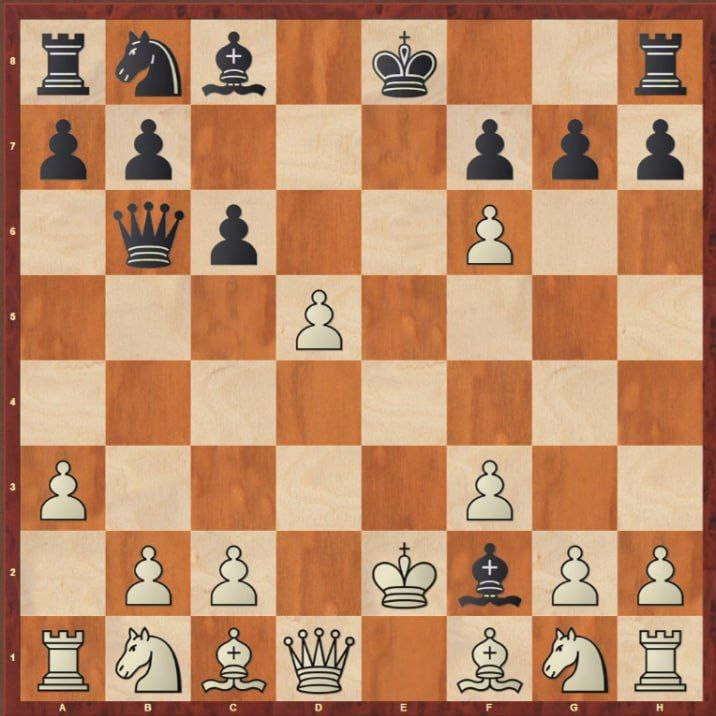A setback at the Blitz World Championship is just an unfortunate incident: here are five of the most intriguing matches from Vasyl Ivanchuk's career.
Let’s recall five fascinating games featuring Vasyl Mykhailovych, where the Ukrainian grandmaster showcased his chess ingenuity, transforming ordinary positions into works of art.
Vasyl Ivanchuk – Veselin Topalov, 1996
The game between two enthusiasts of aggressive play featured the Scheveningen variation of the Sicilian Defense, followed by a series of exchanges of minor pieces.
On move 27, the Bulgarian chess player opted against simply defending the weak pawn on f7, playing more aggressively but inaccurately with Kc6. In response, Ivanchuk ignored the opportunity to lose a rook and made an incredible move to g6. The main idea was to remove the black pawn on f7 for the white-squared bishop. If hxg7 was played, the rook could then take on f7, which cannot be captured by the king due to an immediate queen loss through the discovered check.
Topalov decided to test his luck and Ivanchuk’s intentions, capturing the rook with his knight. After Gxf7 was taken, the black king retreated, sacrificing his rook.
 1
1The Ukrainian could have safely taken the opponent's piece and placed another queen on the board, which would have been immediately captured. Ivanchuk took the rook but chose the knight instead. It’s worth noting that in this case, it wouldn’t have mattered which piece Vasyl Mykhailovych selected. The decision was driven solely by the grandmaster's desire to have a bit of fun.
 2
2After a series of checks and the knight attacking Topalov's queen, the Ukrainian player made the most precise move possible – Ke7. Following this, the Bulgarian resigned, as moving the king to h8 would lead to checkmate in two moves. If the bishop captured the knight, Ivanchuk would play Qf7 and after the king’s retreat – Qg6, leaving Veselin with no chance of saving the game.
 3
3Vasyl Ivanchuk – Baadur Jobava (2010, World Chess Olympiad)
In the opening of the game, the Caro-Kann Defense was employed with its gambit variation. By the fourth move, the Ukrainian grandmaster slightly shocked his Georgian counterpart with the unconventional move a3.
After the exchanges of pawns in the center of the board, Jobava made the best possible move – Bf2+, and Ivanchuk, moving the king back, offered his opponent a draw already on the eighth move of the game. A very interesting psychological maneuver.
 4
4On move 12, the Georgian grandmaster decided to sacrifice a few pieces for the white queen, which did not grant him a decisive advantage. For his strongest piece, Ivanchuk had a rook, a bishop, and a knight.
After some repositioning of pieces and the black pawn loss on h3, Jobava moved his rook to d8, ultimately losing the tempo to develop his attacks. The next move Ra1 trapped the Georgian.
Ivanchuk did not capture the queen on c1, as in that case, the Ukrainian would have received checkmate with Kxf3 (double check). Vasyl Mykhailovych captured the bishop, and after the rook moved to a8, the opponent was forced to resign. Regardless, White had a final material advantage over Black, who remained with just a queen against all of Ivanchuk's minor pieces and one or two rooks.
 5
5Vasyl Ivanchuk – Pavel Eljanov (2008, Annual Tournament in Foros)
In the opening of the game, the Ukrainian players played the queen's gambit, after which Ivanchuk introduced a novelty by moving the pawn to d5 instead of the popular Bf5. After exchanging minor pieces and castling, White gained complete control of the center, nullifying Eljanov's extra pawn.
If Black had played b6, after some exchanges they would have had a strong passed pawn on the A-file and counterplay due to the two rooks. Instead, the Kharkiv player played Bg4, initiating a sort of "race" with the bishop against White's minor pieces.
 6
6Ivanchuk chose not to exchange anything, as it could weaken the pawns on b4 and d4. The opponents traded queens and transitioned into a rook endgame. Pavel's move g5 aimed to disrupt Vasyl Mykhailovych's pawn structure, but the more experienced opponent reinforced his position very precisely with his king.
After another pawn exchange, the white king found itself in the center of the board while his black counterpart remained on the eighth rank. Ivanchuk protected his two pawns with one move and was already threatening to continue his advance, supporting future passed pawns on the kingside.
 7
7Eljanov misjudged the consequences of exchanging rooks and was forced to defend against the passed pawn on f6. At that moment, the very active white king played a crucial role, supporting his own pawn and attacking the black pawn on g5 with one move.
Black almost simultaneously promoted their pawn to a queen, but Ivanchuk, with tempo, offered an exchange. Eljanov could not break White's pawn structure during the game, which played a role in the endgame – two connected passed pawns and a very active king against the unprotected black king and a lone queen. After that, the opponents made eight more moves, after which Pavel Eljanov decided to resign.
 8
8Vasyl Ivanchuk – Viswanathan Anand (Magistral Ciudad de Leon, 2008)
At the tournament in the Spanish city of Leon, the Ukrainian grandmaster achieved one of his fastest victories in his career, decisively defeating the then world champion in blitz and rapid, and later the winner of the chess crown match, Vishy Anand, in just 16 moves.
The opponents played the Nimzo-Indian Defense, calmly developing their pieces and exchanging pawns in the center of the board. The Indian chess player decided to play b6, intending to exploit the weakness of the white diagonal.
However, Ivanchuk did not wait for the next move and immediately advanced the pawn to d5. Anand should have captured the knight on c3, after which the Ukrainian would have been forced to take on e6, and after the bishop retreated and White's piece was moved back, the opponents would have had a symmetrical position.
 9
9The move Nc5 blocked Viswanathan’s dark-squared bishop, which Vasyl Mykhailovych later took advantage of. The chess player moved his rook to d1, forcing the black queen to retreat from the x-ray, after which he advanced the knight to b5. The square c7 was weakened due to the bishop's passivity, which Anand had previously blocked with his pieces.
 0
0The Indian chess player attempted to save his position by attacking the white dark-squared bishop with a pawn, but Ivanchuk immediately created a "fork" for the black queen and rook. Anand declined the queen exchange, retreating his queen to the kingside, but after the move Kh4, he resigned.
The thing is, even in the case of exchanging queens, Black would have been under attack from three pieces at once, one of which would certainly be lost. If the game continued, Ivanchuk would have not only a material advantage but also a more aggressive and flexible position, which would ultimately lead to an even greater defeat for Anand.
 1
1Vasyl Ivanchuk – Istvan Csom (Yerevan, 1989)
If the future legend of Ukrainian chess were a football team, they would say "plays alone and lets the opponent play." In the game against the Hungarian chess player, an atypical situation arose on the board, with three queens present at once.</